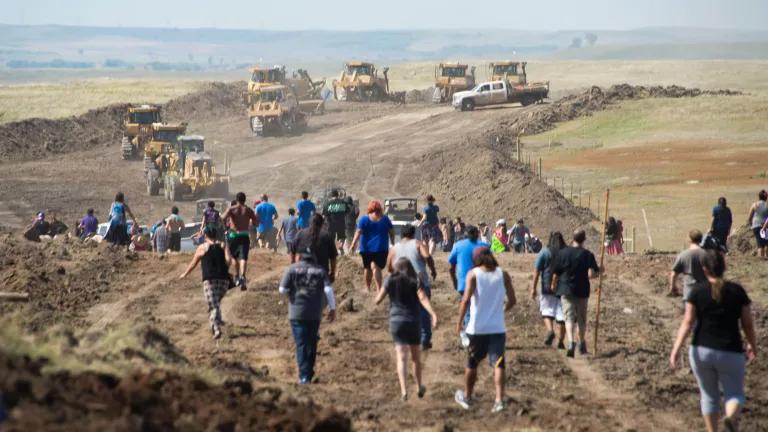NRDC and Partners Sue to Stop the Dirty Water Rule

The Trump administration’s Navigable Waters Protection Rule ignores scientific evidence and endangers the health of our water bodies.
UPDATE: On June 9, 2021, the Biden administration announced it plans to propose to repeal the Dirty Water Rule. While that’s good news, every day that the rule stays in effect, America’s waterways remain at risk. The Biden administration should act quickly to restore full legal protections for the lakes and rivers that supply drinking water to millions of people.
Today, a broad coalition of environmental groups filed a lawsuit to stop the Trump administration’s unlawful decision to gut federal protections for many of the nation’s streams and wetlands. We challenged a regulation from the U.S. Environmental Protection Agency (EPA) and the Army Corps of Engineers called the Navigable Waters Protection Rule. We call it the “Dirty Water Rule” because it excludes millions of miles of rain-dependent streams and millions of acres of flood-preventing, pollution-trapping wetlands from critical safeguards in the Clean Water Act.
NRDC sued along with Clean Wisconsin, Connecticut River Conservancy, Conservation Law Foundation, Massachusetts Audubon, Merrimack River Watershed Council, New Mexico Wilderness Alliance, and Prairie Rivers Network. You can read our lawsuit here.
The Clean Water Act has driven improvements in our nation’s waterways since 1972. For instance, over the past several decades, bacteria and sediment decreased and dissolved oxygen increased, helping make more waters fishable. That’s because raw sewage gets treated before it’s dumped in our rivers. Also, the law prevents industry from dumping more than 700 billion pounds of toxic pollutants every year into the nation’s waters. And the rate of wetlands loss decreased substantially compared to the pre–Clean Water Act era.
We all probably know waterways that are much better today because of the law. The Charles River in Boston, the Potomac in D.C., and Lake Erie have all improved over these 50 years or so. Even the Cuyahoga River in Cleveland, which is the go-to example of polluted U.S. waterways because it caught on fire several times before the Clean Water Act, is now safe for fishing, according to Ohio officials.
As successful as the law has been, the country still has a long way to go on water quality. States report that most waterways they’ve assessed still don’t meet all of the standards they’ve set to keep the water clean enough for things like fishing and swimming. And every year brings numerous stories of slimy, or even toxic, outbreaks of algae, which are often fueled by pollution from sewage plants, urban runoff, and industrial agribusiness.
Sadly, against this backdrop, the Trump administration has finalized a regulation that guts the Clean Water Act. It declares that numerous water bodies that have long been protected by the law will no longer be. With this rollback, the Trump administration has made it easier for these waters to be polluted or destroyed. That’s important because the rule targets streams, wetlands, lakes, and other waters that filter pollution, serve as nurseries for fish, act as natural flood barriers, and feed tens of millions of people’s drinking water supplies. It’s also important because these waters are ubiquitous. For instance, there are more than two million miles of rain-dependent streams in the country, which is likely a major underestimate, and an EPA preliminary analysis of the proposed rule indicated it could exclude approximately 51 percent of the roughly 110 million acres of wetlands in the continental United States. That’s an area larger than California.
This is obviously terrible public policy. And it’s illegal to boot, which is why we’re going to court.
For starters, the Dirty Water Rule relies on a legal theory that no court has accepted and that Supreme Court justices rejected. I’m no math whiz (my kids eclipsed my skills around algebra), but even I know that five is more than four.
Moreover, the agencies failed to do the legally required work of justifying this radical change in policy in light of what it would do to public health and safety, to the environment, and the economy that depends on water resources. In fact, EPA says it can’t estimate the extent of streams, wetlands, or other waters that will lose protection under its rule, nor can it meaningfully assess how increased pollution from the proposal will harm people drinking from more contaminated supplies, fishing or swimming in more polluted waters, or living in flood-prone areas where wetlands have been paved over. Putting out a rule if you don’t have any clue what it’s going to do is reckless, illegal, and just bad government.
Likewise, the administration’s rule unlawfully ignores critical issues without an adequate explanation. In particular, it ignores robust scientific evidence showing that the water bodies it excludes are vitally important. EPA’s own science advisors—many of whom were handpicked by Trump’s EPA heads—reviewed the proposed rule and warned that it flunks basic science.
So, we’re suing. NRDC and our partners will fight this illegal and irresponsible regulation because it endangers the health of our water bodies, the health of the water-dependent economy, and the health and safety of people who rely on vulnerable streams, ponds, and wetlands for drinking water and to trap dangerous floods.




